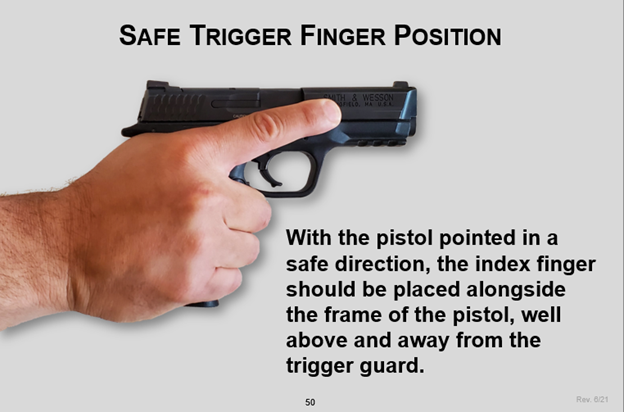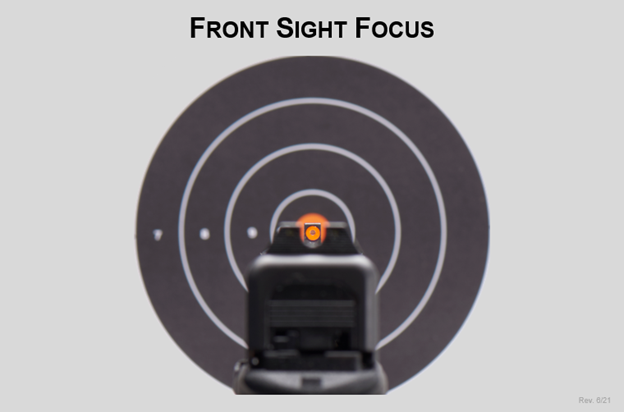In this lesson, we will cover the 3 Pistol Action Types: Single-Action Revolver, Double-Action Revolver, and Semi-Automatic Pistol.
REVOLVERS
First, let’s cover the main parts of a revolver.
A revolver is a pistol that has a rotating cylinder containing a number of firing chambers. The action of the trigger or hammer will line up a chamber with the barrel and firing pin.
A revolver consists of three main parts:
Frame (The frame is the backbone to which all other parts are attached)
Barrel (The barrel is the metal tube through which the bullet passes)
Action (The action is a group of moving parts used to load, fire and unload a pistol)
Now let’s move on the components of the revolver’s frame.
Trigger when pressed it activates the hammer
Hammer causes the firing pin to strike and fire the cartridge
Hammer Spur the projection on the hammer that may be gripped by the thumb
Cylinder holds ammunition in individual chambers that are rotated into firing position by the action of the trigger or hammer
Cylinder Release Latch on double-action revolvers, releases the cylinder to swing out for loading and unloading
Ejector Rod activates the ejector
Single-Action Revolver
In a single-action revolver, the trigger performs a single action: releasing the hammer. The hammer must be manually cocked for each shot.
The action is a group of moving parts used to load, fire, and unload a pistol.
The barrel is the metal tube through which the bullet passes.
Here are the functions of the revolver barrel and characteristics.
Bore: the hole inside the barrel
Rifling: the spiral lands and grooves cut into the bore. Rifling imparts a spin to the bullet which stabilizes its flight
Muzzle: the front end of the barrel where the bullet exits
Front Sight: used with the rear sight in aiming
Caliber: the diameter of the bore, measured across the lands or, sometimes, across the grooves, in decimal fractions of an inch or in millimeters
Double-Action Revolver
In a double-action revolver, the trigger performs two tasks: both cocking and releasing the hammer. Most double action revolvers can also be fired in the single action mode.
Semi-Automatic Pistol
A semi-automatic pistol is a firearm that, each time the trigger is pressed, fires a single cartridge, automatically extracts and ejects the empty case, and inserts a new cartridge into the chamber.
Slide a component that slides on rails in the frame. Upon firing, the slide moves to the rear, and is returned forward to close the breech by pressure from the recoil spring. Some slides enclose the barrel, while others are located at the rear of the barrel.
The slide has three primary functions:
It extracts the cartridge case from the chamber and ejects it from the pistol
It cocks the hammer or firing pin (in most models)
It moves the top cartridge from the magazine into the chamber
The slide may also contain the rear sight and, often, the front sight also. In addition to iron sights, pistols may also have optical, red-dot, or laser sights. The primary advantage of all such sights is that, unlike iron sights, they do not require the alignment of a front and rear sight with the target.
Slide stop: locks the slide in an open position
Safety: a mechanical device the prevents firing of the handgun, and thus helps reduce the chance of an unintentional discharge (sometimes mounted on the slide)
Grip panels: usually made of wood, rubber, or plastic and are attached to the lower portion of the frame - also called stocks.
Back strap: the rear vertical portion of the frame that lies between the grip panels
Front strap: the front vertical portion of the frame that lies between the grip panels
Magazine release: a device that release the magazine so that it can be removed from the pistol
Trigger guard: protects the trigger and reduces the possibility of an unintentional discharge
Trigger: when pressed it activates the hammer
Takedown lever: a lever, or other device, on the frame that, when activated, allows the slide and barrel to be separated from the frame.
When shooting a pistol with iron sights, visual focus should be on the Front Sight. This will leave the target and rear sight slightly fuzzy, as shown at left, but clear enough to establish proper sight alignment and sight picture.













